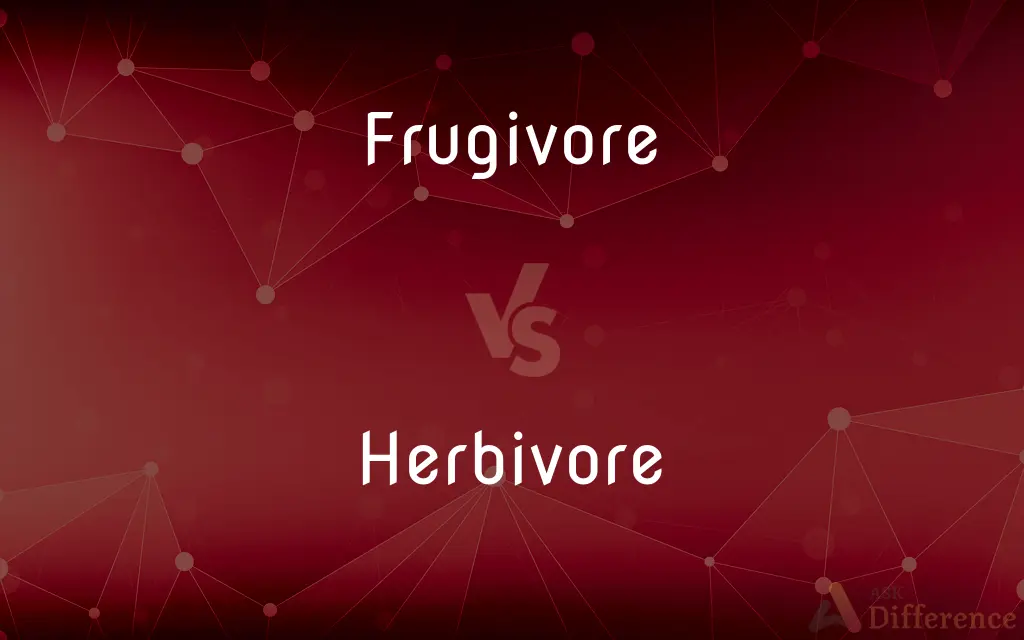Frugivore vs. Herbivore — What's the Difference?
By Urooj Arif & Fiza Rafique — Updated on April 16, 2024
Frugivores primarily consume fruits, optimizing for soft, ripe fruits rich in sugars; herbivores have a broader diet including leaves, stems, and roots, focusing on nutrient-rich plant parts.

Difference Between Frugivore and Herbivore
Table of Contents
ADVERTISEMENT
Key Differences
Frugivores specialize in eating fruits, which often requires adaptations for climbing and reaching fruits on trees, while herbivores may feed on a variety of plant parts, including ground-level vegetation like grasses and shrubs. Frugivores typically have digestive systems optimized to break down sugars and fibers found in fruits, whereas herbivores often possess complex stomachs or enlarged cecums to assist in breaking down cellulose from various plant parts.
Frugivores, such as many birds and some primates, usually have a very colorful diet, mainly consisting of fruits, which are generally high in sugar and water content. On the other hand, herbivores like cows and deer consume a diet primarily composed of leaves, stems, and roots, which are richer in fiber but lower in sugar. This difference in diet influences their overall nutrition intake and energy usage.
In ecological roles, frugivores often act as seed dispersers, aiding in the propagation of fruit-bearing plants. In contrast, herbivores may play roles in shaping the physical structure of the vegetation through their feeding habits. For instance, large herbivores like elephants can significantly alter the landscape by trampling and consuming large amounts of vegetation.
Behavioral adaptations also differ between frugivores and herbivores due to their dietary needs. Frugivores may exhibit behaviors that allow them to access fruits that are out of reach for many other animals, such as flying or agile climbing. Herbivores, however, might develop migratory patterns to follow the growth of ground vegetation across seasons.
Reproductive strategies can also be influenced by their diets; frugivores might time their breeding seasons to coincide with peak fruit abundance to ensure ample food supply for their offspring. Herbivores might have more flexible breeding patterns, as their food sources might be more consistently available year-round.
ADVERTISEMENT
Comparison Chart
Diet Composition
Primarily fruits
Leaves, stems, roots, and other plants
Digestive Adaptation
Simple stomachs, shorter intestines
Complex stomachs, longer intestines
Ecological Role
Seed dispersers
Landscape shapers, grazing impacts
Behavioral Traits
Climbing, reaching for fruits
Ground feeding, migratory patterns
Reproductive Timing
Timed with fruit seasons
Less dependent on specific seasons
Compare with Definitions
Frugivore
An organism that primarily eats fruits.
The toucan, a colorful frugivore, thrives on a diet of tropical fruits.
Herbivore
Impact on their ecosystems by controlling plant growth.
By grazing, herbivores like bison help maintain the health of grasslands.
Frugivore
Animals adapted to digest high sugar and fiber diets.
Bats, as frugivores, play crucial roles in night-time pollination and seed dispersal.
Herbivore
An animal that feeds on plants.
The elephant, a massive herbivore, consumes hundreds of pounds of vegetation daily.
Frugivore
Often involved in symbiotic relationships with fruit-bearing plants.
The frugivorous monkeys disperse seeds through their feces, aiding forest regeneration.
Herbivore
Includes grazers and browsers depending on plant part preference.
While sheep graze on grass, giraffes browse the higher leaves of trees as herbivores.
Frugivore
Usually possess physical adaptations for reaching and consuming fruits.
Many frugivores, like orangutans, have flexible limbs ideal for climbing fruit trees.
Herbivore
Adapted to digest cellulose-rich plant material.
Cattle have specialized stomachs to break down tough plant fibers they consume as herbivores.
Frugivore
Typically found in environments rich in fruit-producing vegetation.
Frugivores are especially common in tropical rainforests where fruit availability is high year-round.
Herbivore
Often form large migratory herds in search of food.
Wildebeest, as herbivores, undertake long migrations to follow the seasonal growth of grasses.
Frugivore
A frugivore is an animal that thrives mostly on raw fruits or succulent fruit-like produce of plants such as roots, shoots, nuts and seeds. Approximately 20% of mammalian herbivores eat fruit.
Herbivore
A herbivore is an animal anatomically and physiologically adapted to eating plant material, for example foliage or marine algae, for the main component of its diet. As a result of their plant diet, herbivorous animals typically have mouthparts adapted to rasping or grinding.
Frugivore
An animal, such as a chimpanzee or fruit bat, that feeds primarily on fruit.
Herbivore
An animal that feeds chiefly on plants.
Frugivore
An animal whose diet is mostly fruit.
Herbivore
An organism that feeds chiefly on plants; an animal that feeds on herbage or vegetation as the main part of its diet.
Herbivore
One of the Herbivora.
Herbivore
Any animal that feeds chiefly on grass and other plants;
Horses are herbivores
The sauropod dinosaurs were apparently herbivores
Common Curiosities
Can frugivores eat other foods besides fruits?
While primarily fruit eaters, some frugivores may occasionally consume other plant parts or insects.
What types of plants do herbivores eat?
Herbivores eat various plant parts, including leaves, stems, and roots.
Do herbivores have any natural predators?
Yes, many herbivores are preyed upon by carnivores and omnivores.
What primarily makes up the diet of a frugivore?
Frugivores primarily consume fruits.
How do frugivores contribute to their ecosystems?
Frugivores contribute by dispersing seeds of the fruits they consume.
Are all frugivores tropical?
Many frugivores are found in tropical regions, but some live in temperate zones.
What role do frugivores play in agriculture?
Frugivores can impact agriculture positively by dispersing cultivated fruit seeds, but sometimes they are considered pests.
What adaptations help herbivores digest tough plants?
Adaptations like multiple stomach chambers and specialized bacteria assist in digestion.
What are some examples of digestive adaptations in herbivores?
Herbivores often have complex stomachs or enlarged cecums for breaking down cellulose.
How do the physical traits of herbivores support their diet?
Physical traits like strong jaws and flat teeth help herbivores grind plant material.
How do herbivores affect the spread of plant species?
Herbivores can spread plant species by dispersing seeds through their feces, though less targeted than frugivores.
Do frugivores migrate like some herbivores?
Some frugivores may migrate, but their patterns are generally less extensive than those of herbivores.
Are there any endangered frugivores?
Yes, some frugivore species are endangered, often due to habitat loss and changes in fruit availability.
How does the behavior of frugivores differ from herbivores?
Frugivores often exhibit behaviors aimed at reaching and consuming fruits, unlike herbivores, who may focus on ground-level foraging.
What is the impact of herbivores on forest areas?
Herbivores can affect forest structure by consuming undergrowth and young saplings.
Share Your Discovery

Previous Comparison
Conman vs. Grifter
Next Comparison
Anterior vs. VentralAuthor Spotlight
Written by
Urooj ArifUrooj is a skilled content writer at Ask Difference, known for her exceptional ability to simplify complex topics into engaging and informative content. With a passion for research and a flair for clear, concise writing, she consistently delivers articles that resonate with our diverse audience.
Co-written by
Fiza RafiqueFiza Rafique is a skilled content writer at AskDifference.com, where she meticulously refines and enhances written pieces. Drawing from her vast editorial expertise, Fiza ensures clarity, accuracy, and precision in every article. Passionate about language, she continually seeks to elevate the quality of content for readers worldwide.














































